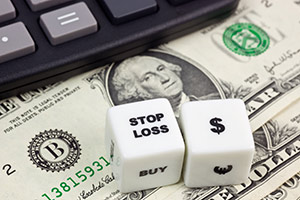The New York Stock Exchange recently announced that it will no longer accept stop orders (including stop-limit and stop-loss orders) beginning Feb. 26, 2016. That's on the heels of similar announcements from Nasdaq and BATS.
That means that three of the biggest exchanges in the country will no longer allow investors to place stop orders on their trades.
While some brokerage houses are likely to keep them intact to attract retail investors, they will be executed internally rather than on the major exchanges.
Stops were designed to help investors limit their downside risk and protect their profits. They allowed investors to go about their lives with a failsafe in place in the event they were not in front of their trading screens to manage their positions - which, for individual investors like you, is most of the time.
So what are you - the average retail investor - to do? How are you supposed to protect your capital and your profits? Let me offer you a few considerations that will help you (and the capital in your account) survive this move by the major exchanges.
Let's get started...
Why Exchanges Are Ditching Stop-Loss Orders
 As we've talked about before, a stop-loss order is an order to close a position if it trades to a specific, pre-determined price.
As we've talked about before, a stop-loss order is an order to close a position if it trades to a specific, pre-determined price.
For example, let's say you buy a stock for $42.50 and you set your stop-loss at $42. When the stock trades down to $42, your stop-loss order turns into a market order to sell that stock. The next trade will be yours at whatever the market price is at that time, which may be $42 or a bit less.
If you're using options, a stop-loss order acts in much the same way. Let's say you buy an option at $4.00 and you place a stop-loss order at $3.00. At the time the market trades at $3.00, the market order will automatically be placed and the next trade is where you will sell the option, which may be that $3.00 or less, depending on the market.
The biggest concern with a stop-loss order is the fact that once your order triggers, it turns into a market order. In a fast-moving market, the stop price can be hit and the next price at which the trade will be executed can be much lower and result in bigger losses than anticipated - exactly what you wanted to avoid by using a stop order in the first place.
And sometimes, your position can come back and trade higher on the day after your stop is triggered, making you wish you never got out in the first place.
The stock exchanges want you to believe that is the reason they are eliminating the stop-loss order - because retail investors use them without understanding these two crucial points: that your stop order is a market order once it's been triggered, and you may get bounced out of positions just before they trade higher.
That may be one of the reasons, but it isn't the only one.
You see, stop orders are rarely used - they represent something like 2% of all orders placed on exchanges. Professional traders don't use them because they are in front of their trading screens all day. Stop orders are used almost exclusively by retail investors - that means you.
Remember to check with your brokerage and see how they want you to go about using/placing stop-loss orders with them or through their trading platform going forward.
Or you can consider using these helpful tools instead...
[mmpazkzone name="in-story" network="9794" site="307044" id="137008" type="4"]
Two Ways to Survive Without Stop-Loss Orders
Using Price Alerts
Price alerts are NOT orders to close a trade (for more on those, go here).
Once you get your fill to open a stock or an option position, you can then place a price alert on it. This will alert you once your position has traded to a predetermined price. But instead of the trade being executed as a market order, you'll be alerted via text or email (find out what kind of alerts your broker's trading platform can provide).
When you receive this alert, you can then go to your screens and see what the market conditions are and determine what type of closing order you wish to use and at what price to do so, putting you in total control!
Price alerts will still require you to place your official order to close the trade, but that's OK by me, because that means YOU are in control of placing the order versus being at the mercy of a computer program or current market pricing.
Trading Options
If you're a Money Calendar Alert subscriber, or if you've seen some of the case studies we've done at Power Profit Trades, you know that I don't use stop-loss orders on my options trades.
That's because I slash my risk down to $500 or less for every trade - and I'm comfortable with the prospect of losing 100% on each trade, so there's no need to use stops.
If you wanted to own 100 shares of FedEx Corp. (NYSE: FDX), which is currently trading around $162, you'd have to shell out $16,200 for the privilege.
If you place a 25% stop-loss on the position and the stock drops 25%, that's going to cost you $4,050.
Or you could just buy a call option that would allow you to control those same 100 shares for a fraction of the cost and a fraction of the risk - without having to use stops. If you bought an FDX call option for $2.50 (or $250 per contract), and that option expired worthless, all you'd lose is that $250.
You can think of your options trades as having the same risk control that you get with stop-loss orders... without the cost risk of traditional stock trades.
Your Survival Depends on One Thing
No matter what you do, your survival is going to come down to how well you build your trade plan and stick to it.
If you are the type that changes your mind or looks for a reason to hang on to a losing position when the stock or option is not working, you will have a much harder time using price alerts than those that plan their trade and trade their plan.
As long as you stick to your trade plan, you'll survive - and even thrive. Because any good trade plan begins with the idea that capital preservation is the absolute key to success.
Follow us on Twitter @moneymorning or like us on Facebook.
Stick to Your Plan: There is an old adage that traders are told to live by that goes, "Plan your trade and trade your plan." It's solid advice for beginning and experienced traders alike. Changing your plan mid-trade only ever ends up reinforcing one crucial, often painful, lesson...
About the Author
Tom Gentile, options trading specialist for Money Map Press, is widely known as America's No. 1 Pattern Trader thanks to his nearly 30 years of experience spotting lucrative patterns in options trading. Tom has taught over 300,000 traders his option trading secrets in a variety of settings, including seminars and workshops. He's also a bestselling author of eight books and training courses.



